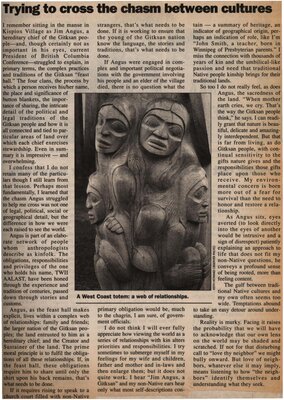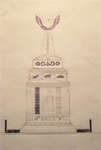"Trying to Cross the Chasm between Cultures"
- Full Text
- Trying to cross the chasm between culturesI remember sitting in the manse in Kisipiox Village as Jim Angus, a hereditary chief of the Gitksan people - and, though certainly not as important in his eyes, current President of British Columbia Conference - struggled to explain, in primary terms, the complex practices and traditions of the Gitksan "feast hall." The four clans, the process by which a person receives his/her name, the place and significance of button blankets, the importance of sharing, the intricate detail of the political and legal traditions of the Gitksan people and how it is all connected and tied to particular areas of land over which each chief exercises stewardship. Even in summary it is impressive - and overwhelming.
I confess that I do not retain many of the particulars though I still learn from that lesson. Perhaps most fundamentally, I learned that the chasm Angus struggled to help me cross was not one of legal, political, social or geographical detail, but the different in how we were each raised to see the world.
Angus is part of an elaborate network of people whom anthropologists describe as kinfolk. The obligations, responsibilities and privileges of the one who holds his name, TWII AALAST, have been honed through the experience and tradition of centuries, passed down through stories and customs.
Angus, as the feast hall makes explicit, lives within a complex web of relationships: family and friends; the larger nation of the Gitksan peoples; the land entrusted to him as a hereditary chief; and the Creator and Sustainer of the land. The prime moral principle is to fulfill the obligations of all these relationships. If, in the feast hall, these obligations require him to share until only the shirt upon his back remains, that's what needs to be done.
If it requires rising to speak to a church court filled with non-Native strangers, that's what needs to be done. If it is working to ensure that the young of the Gitksan nation know the language, the stories and traditions, that's what needs to be done.
If Angus were engaged in complex and important political negotiations with the government involving his people and an elder of the village died, there is no question what the primary obligation would be, much to the chagrin, I am sure, of government officials.
I do not think I will ever fully appreciate how viewing the world as a series of relationships with kind alters priorities and responsibilities. I try sometimes to submerge myself in my feelings for my wife and children, father and mother and in-laws and then enlarge them; but it does not quite work. I hear "Jim Angus, a Gitksan" and my non-Native ears hear only what most self-descriptions contain - a summary of heritage, an indicator of geographical origin, perhaps an indication of role, like I'm "John Smith, a teacher, born in Winnipeg of Presbyterian parents." I miss the connection with thousands of years of kind and the umbilical-like passion and need that traditional Native people kinship brings for their traditional lands.
So too I do not really feel, as does Angus, the sacredness of the land. "When mother earth cries, we cry. That's the way the Gitksan people think," he says. I can readily grant that nature is beautiful, delicate and amazingly interdependent. But that is far from living, as do Gitksan people, with continual sensitivity to the gifts nature gives and the responsibilities those gifts place upon those who receive. My environmental concern is born more out of a fear for survival than the need to honor and restore a relationship.
As Angus sits, eyes averted (to look directly into the eyes of another would be intrusive and a sign of disrespect) patiently explaining an approach to life that does not fit my non-Native questions, he conveys a profound sense of being rooted, more than feeling content.
The gulf between traditional Native cultures and my own often seems too wide. Temptations abound to take an easy detour around understanding.
Reality is murky. Facing it raises the probability that we will have to acknowledge that our own lens on the world may be shaded and scratched. If not for that disturbing call to "love thy neighbor" we might bully onward. But love of neighbors, whatever else it may imply, means listening to how "the neighbors" identify themselves and understanding what they seek.
- Mystery Question
- In what publication did this article appear? In what year was this article written? Who wrote this article?[Please answer by clicking on the Comments tab]
- Howard, Keith, Photographer
- Media Type
- Newspaper
- Item Types
- Articles
- Clippings
- Description
- "I remember sitting in the manse in Kispiox Village as Jim Angus, a a hereditary chief of the Gitksan people - and, though certainly not as important in his eyes, current president of British Columbia Conference - struggled to explain, in primary terms, the complex practices and traditions of the Gitksan "feast hall."
- Subject(s)
- Personal Name(s)
- Angus, Jim.
- Local identifier
- SNPL001276v00d
- Language of Item
- English
- Creative Commons licence
 [more details]
[more details]- Copyright Statement
- Public domain: Copyright has expired according to Canadian law. No restrictions on use.
- Contact
- Six Nations Public LibraryEmail:info@snpl.ca
Website:
Agency street/mail address:1679 Chiefswood Rd
PO Box 149
Ohsweken, ON N0A 1M0
519-445-2954



